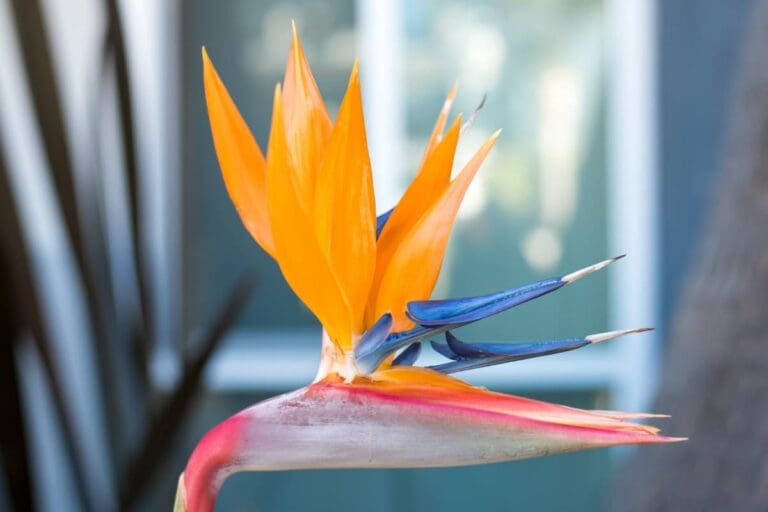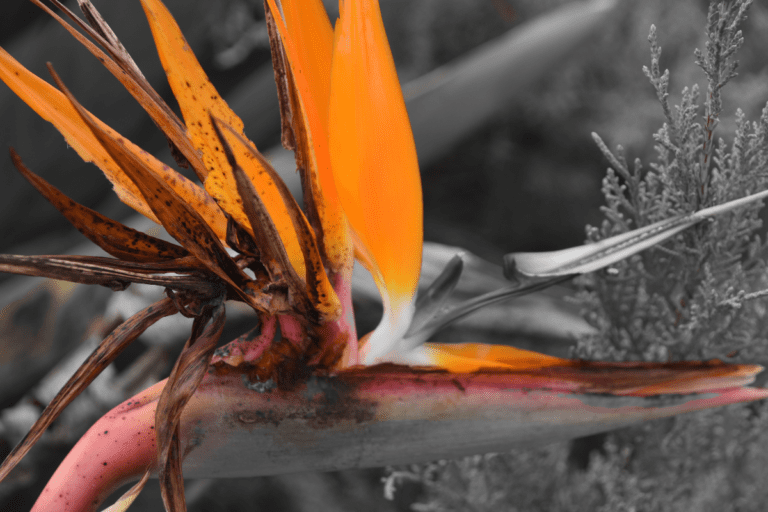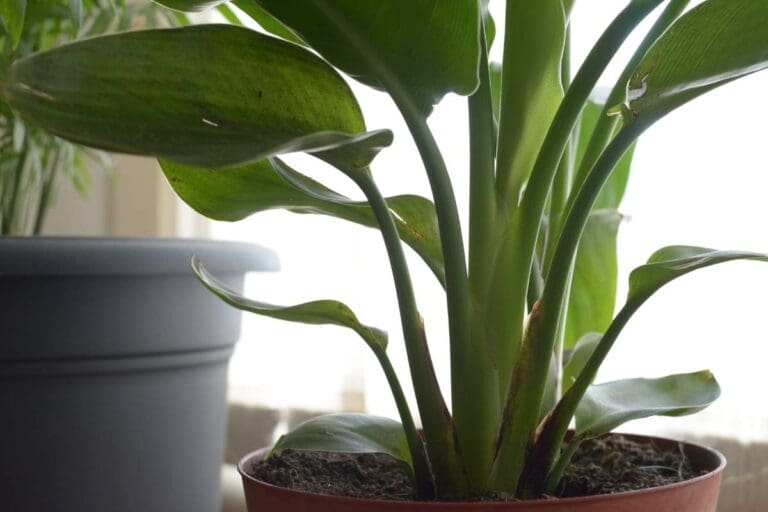Can Bird Of Paradise Survive Freeze?
The bird of paradise is a beautiful tropical plant loved for its large green foliage and spiky blooms. But, if you want to grow this beauty, you must know whether it can survive freezing.
The bird of paradise is a tropical and frost-tender plant that can survive cold temperatures up to 24°F. However, temperatures that low or a freeze can damage and even kill the plant’s thin, broad leaves and flowers. Cover the plant or bring it indoors to protect it from the freeze.
This article will discuss how to help your bird of paradise survive freezing. This guide will also explain how to protect your plant from cold temperatures. So keep reading.

Please note: Simplify Plants is reader-supported. Some links in the post are affiliate links and I get a commission from purchases made through links in the post.
Understanding the tolerance of bird of paradise to cold temperatures
Let’s look at all the factors that affect the temperature tolerance of birds of paradise.
The native habitat of bird of paradise
The bird of paradise (Strelitzia reginae) is native to subtropical coastal areas of South Africa and is grown worldwide.
They are warmth-loving plants, need sustainable temperatures to grow, and can’t tolerate frost.
The bird of paradise plant is mostly cultivated in the north, south, Central America, and Portugal.
They have large, thick, waxy leaves and are often confused with the banana tree.
They produce orange and blue flowers with two narrow petals and five stamens.
They can grow up to 15-20 feet tall in their natural habitat.
However, as a houseplant, they will grow 3 to 5 feet tall.
They are most suitable for USDA zones 10 to 12 and sometimes 9 with special care.
The temperature range that bird of paradise can tolerate
| Temperature Range | Bird of Paradise Plant’s Tolerance |
|---|---|
| Above 32°F (0°C) | Can survive with minimal damage |
| 28°F to 32°F (-2°C to 0°C) | Can survive with some damage |
| 24°F to 28°F (-4°C to -2°C) | Can survive with significant damage |
| Below 24°F (-4°C) | Likely to die or sustain severe damage |
Birds of paradise are tough, drought-tolerant, and easy-to-grow plants.
They like growing in warm temperatures and humid environments.
A bird of paradise prefers temperatures of 55-65°F at night and 65-85°F during the day.
They can survive temperatures up to 24°F for a short time without damage.
The plant will suffer serious cold damage if the temperature falls below this range.
The plant will stop blooming, and its growth will get stunted.
The freeze will cause the plant leaves to turn yellow, brown, limp, and dry.
Other signs of freeze damage include brown or black stems, limpness, and soft dark spots in the plant’s trunk.
The plant can recover from the cold damage if the roots remain undamaged.
The factors that influence the survival of bird of paradise

The following factors influence the survival and growth of the bird of paradise plant:
Light
The bird of paradise plant requires 6 to 8 hours of bright indirect light or direct sunlight.
During summers, it will require shielding from direct sunlight; otherwise, the plant’s leaves will get scorched.
I have experienced sunburns with my bird of paradise, so I suggest you keep your plant in a place that is away from intense direct light.
A good position for them is an east or west-facing window.
During the winter, when light levels are low, the plants are at a higher risk of freeze damage.
So, try to provide your plant with sufficient light during the winter by keeping it in a brightly lit area or using grow lights.
Humidity
The bird of paradise are tropical plants, so they prefer higher humidity levels.
The plant will need at least 50% humidity for growth and survival.
During the winter, the humidity levels drop, due to which the plants lose too much water through transpiration and get dehydrated.
And on top of that, the plant can even die if it gets hit by the freeze!
To avoid such a scenario, provide enough humidity using a humidifier, especially if you have an indoor bird of paradise.
Soil
The bird of paradise will thrive best if you use rich, loamy, well-drained, slightly acidic soil with a pH between 5.5 and 7.5.
Only use potting soil that drains well.
Mulching the soil is a great way to help the birds of paradise survive the cold.
Watering
The bird of paradise plant prefers to grow in moist but not soggy soil.
During the winter, the plant goes dormant, so water it every 1-2 weeks.
But don’t just go by my words; always check the moisture before watering the plant.
Water the plant thoroughly until the excess water drains from the soil.
Fertilization

The bird of paradise plant is a heavy feeder.
But, fertilize the plant with a balanced, diluted liquid fertilizer once a month during the winter.
Avoid fertilizing it frequently during winter, and if you have a frost-affected bird of paradise, don’t fertilize it at all and let it recover first.
Effects of a freeze on the bird of paradise
| Sign of Damage | Description |
|---|---|
| Blackened leaves | Leaves turn black and wilted due to frost damage. |
| Soft stems | Stems become soft and mushy due to freezing. |
| Brown spots on leaves | Leaves develop brown spots due to frost damage. |
| Leaf drop | Leaves start to drop off the plant due to damage. |
| Slow growth | Plant growth slows down due to damage. |
Here are the harmful effects of a freeze on the bird of paradise plant.
If you notice any of these signs, check the plant thoroughly to understand if it has been affected by frost.
1. Discoloured leaves
The lush green leaves of the plant will suddenly change their color if a freeze hits them.
The leaves will first turn yellow and later brown or black.
2. Tattered leaves
Leaf tattering is one of the first signs of freeze damage in the bird of paradise plant.
The frostbitten leaves will get many small splits on their edges.
3. Soft, spongy leaves
Some of the frostbitten leaves will become soft and spongy.
The ice crystal formation inside the leaves will increase the moisture content, making them soft and spongy.
The tissue’s cell wall gets destroyed, due to which the water flows easily through the broken tissues.
Therefore, the leaves will feel soft and spongy when we press them.
4. Black and mushy stems

The stem and trunk of the plant will turn black and mushy.
They will start to rot and will become soft and spongy.
5. No blooms
The buds of the plant will die if they get frostbite.
It begins to bloom only after the plant has recovered from cold damage.
6. Stunted growth
The plant will stop growing if it is cold-damaged.
However, if you take care of your plant properly, there are chances for its early recovery.
Preparing bird of paradise for freeze conditions
| Step | Description |
|---|---|
| Water the plant | Water the plant thoroughly before the freeze to help it retain moisture and survive better. |
| Cover the plant | Cover the plant with a cloth, blanket, or frost cloth to protect it from the cold. |
| Add heat source | Add a heat source like a string of Christmas lights or a space heater to create warmth around the plant. |
| Avoid using plastic | Avoid using plastic to cover the plant as it can trap moisture and cause more damage. |
You can protect your bird of paradise plant from freeze damage by providing ideal growing conditions.
I’ve done these to protect my bird of paradise and multiple other plants from frost.
1. Bring your bird of paradise plant inside.
The best way to protect your bird of paradise plant from freezing damage is by bringing it inside before the weather gets too cold.
If you are in a place where the temperature drops frequently, overwinter the plant indoors in a protected area that remains safe and warm.
Try maintaining an average indoor temperature of 65-85°F around your plant.
Keep the plant away from drafty windows, open doors, windows, leaking windowsills, etc.
I often cover my windows with thick curtains to keep my room warm, so you can also try this method.
You can install heaters in your room to maintain warm temperatures around the plant.
Also read: Where To Place Bird Of Paradise Indoors?
2. Provide your bird of paradise plant with sufficient light.
The bird of paradise is a sun-loving plant.
But during the winter, the intensity and duration of light reduce, due to which the plants fall into a higher risk of freeze damage.
To deal with this situation, keep your plant in a place where it can get sufficient sunlight.
Keep the plant near a south-facing to provide maximum sunlight in the morning.
You can also keep the plant outside for a few hours during the daytime when temperatures are warm.
You can use artificial grow lights if you feel your plant isn’t getting sufficient light.
I have used grow lights, and they are effective.
You can get the lights easily from online marketplaces.
Make sure to rotate your plant every 2 to 3 days so that all the sides of the plant receive sunlight.
3. Cover your bird of paradise with a frost cloth or other protective materials.

You can protect your bird of paradise plant from a cold snap by wrapping the leaves and flower buds with a frost cloth.
Put the frost cloth directly over the plant and secure it to the soil surface with stones.
Keep the cloth slightly loose on the plant to prevent the leaves from tearing.
4. Water your bird of paradise plant wisely.
The bird of paradise watering requirement changes during the winter season.
The plant will need less than half its usual water intake.
Always check the soil before watering your plant.
Water the plant only when the top 2-3 inches of soil feels dry.
If you are a beginner, you can use a moisture meter that will tell you when your plant needs watering.
5. Take care of humidity
Providing the bird of paradise plant with sufficient humidity is difficult during the winter.
If the plant is exposed to low humidity, it will suffer from stress and various other problems.
You can increase the humidity around your plant by misting its leaves, grouping it with other tropical plants, or using a humidifier device.
5. Reduce fertilization
The bird of paradise will need some amount of fertilization during winter.
The plant goes dormant and doesn’t actively grow, so fertilizing it once a month should be enough.
If you have recently repotted your bird of paradise, avoid fertilizing it, as the soil already has enough nutrients for its growth.
6. Mulch the soil
The bird of paradise will benefit from a 2 to 3-inch deep layer of organic mulch.
Mulching will help in protecting your plant from cold temperatures by preventing its roots from freezing.
You can prepare an organic mulch using ingredients like pine straws, wood chips, leaves, and pine needs.
The severity of proper soil moisture and its effects on plant health

If the soil of the bird of paradise plant freezes, it will hurt the plant’s health.
Although the bird of paradise can tolerate low temperatures of up to 24°F, it is only for a brief period.
The soil will freeze if the temperature drops to 32°F.
If this happens, the water present in the soil will solidify along with soil particles.
As a result, the plant will undergo a variety of problems.
Frozen soil will also damage the roots of the plant.
The freeze will cause the soil to crack, due to which the cold air enters into the soil particles.
The cold air will damage your plant’s roots and can even kill it.
As a result, the roots will lose their ability to transfer water and nutrients, so the plant’s health will decline, and after some, it will die.
Many times the plant’s container will break if the soil freezes.
When the frozen soil melts, the soil will become muddy, and such conditions will promote mold growth.
So, to prevent frozen soil, grow your plant in protective containers, which will maintain the soil temperature.
The likelihood of plant recovery after freeze damage
The bird of paradise plant will recover if it has a slight injury due to freeze damage.
They are slow-growing plants and will take much time to recover.
However, if you catch the early signs of freeze damage, there are chances your plant will quickly recover within a few weeks.
If the freeze damage is severe, the plant will take a long time to grow new leaves and flowers.
The damaged leaves and flower buds will not recover, so you can prune them off.
Taking good care of the plant and providing it with ideal growing conditions will increase the recovery rate.
However, there is no chance for your plant’s recovery if its roots are frozen.
As soon as you suspect frost damage, remove your plant from the pot and inspect it for any damage.
If the roots have turned soft and mushy and the soil feels muddy, it’s too late for your plant to recover from its injuries.
Final words
The bird of paradise is a sturdy, gorgeous plant that thrives without much care. The plant can survive a slight freeze; however, a severe frost can be life-threatening.
If you live in an area that experiences freeze and intense colds, this article is right for you. You just need to remember a few basic points to protect your plant from cold damage.
Provide your bird of paradise plant with a lot of sunlight, reduce watering and fertilization, and maintain ideal temperatures and humidity. Monitor your plant daily to avoid missing any signs of cold damage.
Making a few changes in the plant’s care routine and taking good care during winter will protect your bird of paradise from freeze damage.
What are the initial signs of cold damage in bird of paradise plants?
The initial signs of cold damage in the bird of paradise plant are yellow leaves. The leaves will appear ragged, and you must prune them off. Over time, the plant’s stem will turn brown or black, the leaves will drop, and the plant will become lanky.
When should I prune my bird of paradise plant?
The best time to prune the bird of paradise plant is during the spring season. It is because pruning the plant during the winter season can cause it serious stress and shock. You can, however, get rid of any damaged leaves, stems, or buds during any season.
Reference: Wikipedia.
Recommended Garden Supplies
| Product Image | Our Recommended Gardening Supplies | Check Offers! |
|---|---|---|
Top Top
Top
Top
Top
Top
Top
Top
Top | rePotme Houseplant and Tropical Classic Potting Soil Mix | Check Offer On Amazon |
 Top
Top
Top
Top
Top
Top
Top
Top | Espoma Organic Indoor Plant Food | Check Offer On Amazon |
 Top
Top
Top
Top
Top
Top
Top
Top | GooingTop LED Grow Light 6000K Full Spectrum Clip Plant Growing Lamp | Check Offer On Amazon |
 Top
Top
Top
Top
Top
Top
Top
Top | Soil Moisture Meter | Check Offer On Amazon |
 Top
Top
Top
Top
Top
Top
Top
Top | Govee Hygrometer Thermometer, Bluetooth Enabled! | Check Offer On Amazon |
 Top
Top | LEVOIT Humidifiers for Large Room(Best For Plants) | Check Offer On Amazon |
 Top
Top
Top
Top
Top
Top
Top
Top | Upgraded DIY Automatic Drip Irrigation Kit, 15 Potted Houseplants Support | Check Offer On Amazon |
 Top
Top
Top
Top
Top
Top
Top
Top | Stainless Steel Heavy Duty Gardening Tool Set | Check Offer On Amazon |
 Top
Top
Top
Top
Top
Top
Top
Top | Bonide Insecticidal Soap | Check Offer On Amazon |
 Top
Top
Top
Top
Top
Top
Top
Top | Bonide 32 oz Spray Neem Oil for Organic Gardening | Check Offer On Amazon |
 Top
Top
Top
Top
Top
Top
Top
Top | Garden Safe Fungicide | Check Offer On Amazon |






Fantastic site. A lot of helpful info here. I’m sending it to some buddies ans additionally sharing in delicious. And naturally, thanks on your sweat!